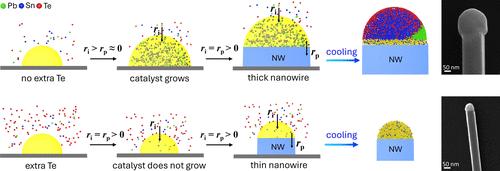具有应变可调铁电相变的超长超薄 Pb1-xSnxTe 纳米线的受控气液固生长
IF 5.4
2区 医学
Q2 MATERIALS SCIENCE, BIOMATERIALS
引用次数: 0
摘要
Pb1-xSnxTe 系列化合物具有各种有趣而有用的物理特性,包括拓扑保护表面态、稳健的铁电性、显著的热电特性和潜在的拓扑超导性。与块状晶体相比,一维(1D)纳米线(NWs)提供了一个独特的平台,可以增强功能特性并实现新的功能,例如实现用于量子计算的一维马约拉纳零模。然而,在真正的 1D 区域实现超细 Pb1-xSnxTe(0 ≤ x ≤ 1)纳米线的可控合成一直是个挑战。在这项工作中,我们报告了在金催化下,以可控方式生长出极细(20-30 纳米)和足够长(几微米到几十微米)的高单晶质量 Pb1-xSnxTe 纳米线的情况。这种可控生长是通过提高金催化剂颗粒中 Te 的掺入量来实现的,从而促进 Sn/Pb 物种的沉淀并抑制颗粒的增大,我们认为增大是超细纳米线生长所面临的主要挑战。我们的生长策略可以很容易地扩展到其他化合物和合金纳米线,其中的组成元素在催化剂颗粒中的掺入率各不相同。此外,Pb1-xSnxTe 纳米线的生长还实现了应变依赖性电传输测量,测量结果表明,沿纳米线轴向的单轴拉伸应变会提高电阻和铁电转换温度,这与结构相稳定性的密度泛函理论计算结果一致。本文章由计算机程序翻译,如有差异,请以英文原文为准。

Controlled Vapor–Liquid–Solid Growth of Long and Remarkably Thin Pb1–xSnxTe Nanowires with Strain-Tunable Ferroelectric Phase Transition
The Pb1–xSnxTe family of compounds possess a wide range of intriguing and useful physical properties, including topologically protected surface states, robust ferroelectricity, remarkable thermoelectric properties, and potential topological superconductivity. Compared to bulk crystals, one-dimensional (1D) nanowires (NWs) offer a unique platform to enhance the functional properties and enable new capabilities, e.g., to realize 1D Majorana zero modes for quantum computations. However, it has been challenging to achieve controlled synthesis of ultrathin Pb1–xSnxTe (0 ≤ x ≤ 1) nanowires in the truly 1D region. In this work, we report on a Au-catalyzed vapor–liquid–solid (VLS) growth of remarkably thin (20–30 nm) and sufficiently long (several to tens of micrometers) Pb1–xSnxTe nanowires of high single-crystalline quality in a controlled fashion. This controlled growth was achieved by enhancing the incorporation of Te into the Au catalyst particle to facilitate the precipitation of the Sn/Pb species and suppress the enlargement of the particle, which we identified as a major challenge for the growth of ultrathin nanowires. Our growth strategy can be easily extended to other compound and alloy nanowires, where the constituent elements have different incorporation rates into the catalyst particle. Furthermore, the growth of thin Pb1–xSnxTe nanowires enabled strain-dependent electrical transport measurements, which shows an enhancement of electrical resistance and ferroelectric transition temperature induced by uniaxial tensile strain along the nanowire axial direction, consistent with density functional theory calculations of the structural phase stability.
求助全文
通过发布文献求助,成功后即可免费获取论文全文。
去求助
来源期刊

ACS Biomaterials Science & Engineering
Materials Science-Biomaterials
CiteScore
10.30
自引率
3.40%
发文量
413
期刊介绍:
ACS Biomaterials Science & Engineering is the leading journal in the field of biomaterials, serving as an international forum for publishing cutting-edge research and innovative ideas on a broad range of topics:
Applications and Health – implantable tissues and devices, prosthesis, health risks, toxicology
Bio-interactions and Bio-compatibility – material-biology interactions, chemical/morphological/structural communication, mechanobiology, signaling and biological responses, immuno-engineering, calcification, coatings, corrosion and degradation of biomaterials and devices, biophysical regulation of cell functions
Characterization, Synthesis, and Modification – new biomaterials, bioinspired and biomimetic approaches to biomaterials, exploiting structural hierarchy and architectural control, combinatorial strategies for biomaterials discovery, genetic biomaterials design, synthetic biology, new composite systems, bionics, polymer synthesis
Controlled Release and Delivery Systems – biomaterial-based drug and gene delivery, bio-responsive delivery of regulatory molecules, pharmaceutical engineering
Healthcare Advances – clinical translation, regulatory issues, patient safety, emerging trends
Imaging and Diagnostics – imaging agents and probes, theranostics, biosensors, monitoring
Manufacturing and Technology – 3D printing, inks, organ-on-a-chip, bioreactor/perfusion systems, microdevices, BioMEMS, optics and electronics interfaces with biomaterials, systems integration
Modeling and Informatics Tools – scaling methods to guide biomaterial design, predictive algorithms for structure-function, biomechanics, integrating bioinformatics with biomaterials discovery, metabolomics in the context of biomaterials
Tissue Engineering and Regenerative Medicine – basic and applied studies, cell therapies, scaffolds, vascularization, bioartificial organs, transplantation and functionality, cellular agriculture
 求助内容:
求助内容: 应助结果提醒方式:
应助结果提醒方式:


